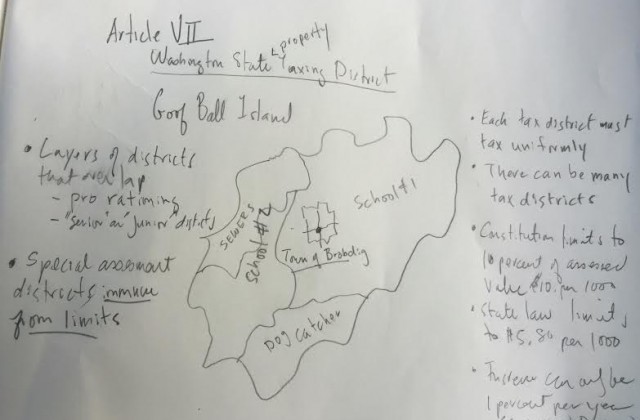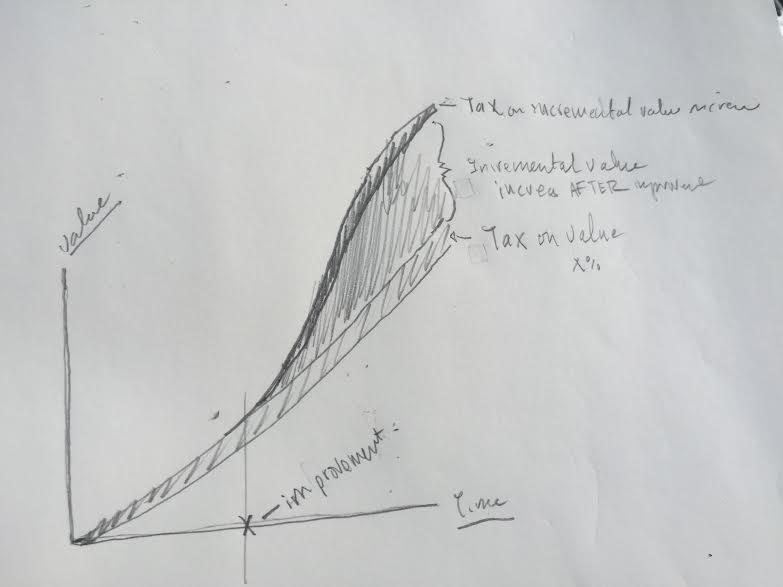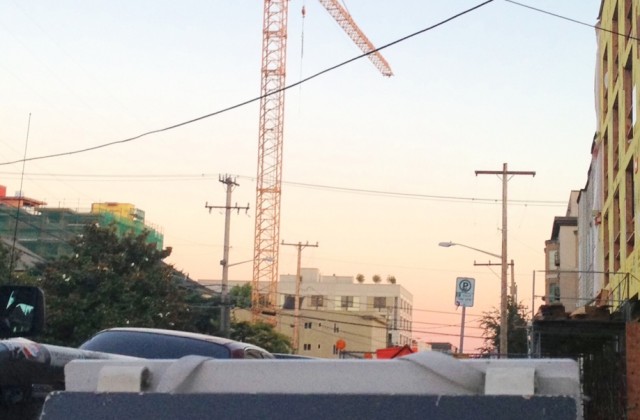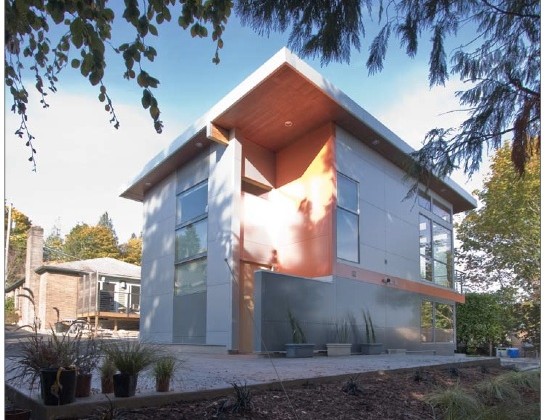Doing the Math? Try Again.
Chris Persons at Capitol Hill housing (who I have sparred with before) has a peculiar post called, “Doing the Math on Homelessness and Housing,” which needs a rewrite I think. I only point it out because the headline claims to “do the math,” and Persons math appears to be wrong and misleading. Let’s take it apart real quick.
Persons writes this:
Let’s take a look at the math. The cost of building a single unit of apartment housing in Seattle depends on a lot of factors, but $200,000 is a reasonable estimate. At that price, housing the estimated 10,000 homeless people in Seattle would cost $2 billion, well beyond what Bill [Hobson] predicted in 2014. The sad truth is that homelessness has only grown since 2014 and the cost of building has skyrocketed. That’s the price of our inaction.
Persons estimate of $200,000 doesn’t pass the red face test, especially for “affordable” housing built using subsidies and low income housing tax credits. Try more like $300,000. Taking the proposal for Capitol Hill Station as an example, where the approved proposal has 418 units at a cost of $124 million. That’s roughly $296,650 per unit. And we can argue about that all day. But the bottom line is that almost all estimates for projects in Seattle have a much higher per unit cost that cited by Persons. I’d love to know how much Capitol Hill Housing paid per unit for it’s projects, though. In my own short stint as a affordable housing developer I discovered that 43 units in Des Moines, with much lower land costs, our units were still more like $275,000 per unit.
So that isn’t a reasonable estimate.
Along with Persons faulty numbers is faulty reasoning. Think about it. Do we need to build brick and mortar housing for every single person who is homeless right now? How long would that take? How much money would it cost to operate those buildings? Who’d get that money? The answer to that last question is obvious: organization like Persons’. And what about the high transaction and labor costs embodied in the cost associated with building units? Can Persons and his colleagues address those?
The biggest issue I’ve heard from homeless advocates is not that everyone needs a one bedroom apartment, but that they need shelter options tonight. They also need to be protected from a Mayor who has essentially declared being homeless illegal and is now engaging in a process of “sweeping” away the problem. I think it’s unconscionable at this time to be banging the drum for funds for units when someone who is sleeping in a car or tent is facing being dislocated by police action. See Tim Harris’ column about this.
Then Persons says that there are 10,000 homeless people in Seattle. Um, no there isn’t. Try more like 2,942.
And the price of our inaction? Persons and his colleagues at the Housing Development Consortium have been very active. They managed to get the Mayor to agree to a Mandatory Inclusionary Zoning (MIZ) proposal with no private developers at the table from outside of downtown. Oddly, however, the Mayor’s big pitch about inclusion (“developers will have to pay a penalty if they don’t build affordable units) is really a shell game. It’s all about generating fees. The Seattle Times caught this not too long ago when it reported that only about 150 inclusionary units would be created by MIZ, with none downtown or South Lake Union.
The truth is that the non-profit housing lobby is incredibly powerful. They don’t want you to know that. Instead, they want to use bad math, homelessness, and the perception that they have few resources to funnel more cash into their coffers. I’m the only person in town who will go on the record saying this and, believe me, it gets me into a lot of trouble. But I also think when “facts” are put into the public realm that aren’t facts someone needs to challenge them. I guess I’m that someone. I would suggest that Persons correct his post and at least get number right even if he insists on suggesting that we build thousands of units of housing with money squeezed out of private development when what many people need is a solution today.
TIFsplainer: Can We Use TIF to Build Housing on City Owned Land?
This post was written very quickly and mostly from memory. If you google my name and Tax Increment Financing, you’ll find a ton of stuff about many different aspects of this. But I wanted to get this all out even with some imperfections to get the conversation going. I’d suggest that along side this post you have the Municipal Research and Services Center (MRSC)’s rundown on property taxes in Washington State. Their resource overrides any errors I may have made below.
I think one big idea was left off the table from the Mayor’s Housing Affordability and Livability Agenda (HALA) Committee recommendations: Tax Increment Financing (TIF). I think it makes sense that this important financing tool has sort of disappeared. I was a big champion of the idea and even I am just coming back to it now after championing it for more than a decade. But I think that the TIF concept needs to be reintroduced into the discussion of how we finance public housing – that is housing that is owned and operated by local government. It’s going to take a lot of words and some pictures to do this, but let’s get started.
What is Tax Increment Financing?
Tax Increment Financing or TIF is a value capture tool that enables local governments to borrow money by selling bonds, use the money to make improvements to infrastructure, and pay the money back by taxing a portion of the increases in property value created by the improvements.
It sounds more complicated than it really is. Imagine if you owned a piece of property with no road, sewer, or water service. That property would be worth a lot more with that infrastructure and would pay more property taxes. What TIF does is borrow money to build that infrastructure then, when the value of the property goes up, pay back the money with the extra taxes it collects. It’s called value capture because the using future increase in property value is what allows improvements today; that increment of increase value is the “I” in TIF.
Greatest diagram in the world courtesy of me.
The key ingredients for successful TIF are time, low interest loans from investors on the bond market and the value from improvements to infrastructure, and investment in the properties that benefit from the infrastructure. Ideally, the pay back of the borrowed money tracks well with tax revenue drawn from the benefitting parcels of land. The reason TIF makes sense for local governments is that it allows them to entice new housing and commercial development where no private investment wants to go because the costs of infrastructure are too high to offset with the revenue from what can be built.
Think about that parcel you own with no road, sewer, or water. If you wanted to sell it to a developer to build housing, she likely wouldn’t want to buy it, no matter what the zoning was because what she could charge for rents or for selling a house wouldn’t pay her back for the road, sewer, and water connections she’d have to build. You could build those things, but who’d loan you the money. What TIF does is allow the breaking of that cycle which results in higher tax revenue to cover the improvements, but also jobs, more housing and retail, and more sales tax.
Why Don’t We Use TIF in Seattle?
Washington State has a peculiar property tax code. The founders of the State worried that some property owners would be unfairly targeted with higher taxes. So they designed a Constitution that required uniform taxation. But they were smart enough to balance that out with creating tax districts. So while the State, counties, and cities are all taxing districts, there are a myriad of other special purpose taxing districts too. The only rule they have to follow set by the Constitution is that they tax no more than 1 percent of the value of the property and that taxes be uniform across all value in the district.
What makes our system counter intuitive is that we don’t assess property taxes on the value of particular property; instead we assess a rate of taxation of the total value of all property in a tax district and apply it across all the value. So if a tax district assesses a 1 percent tax on all property, it starts with the total value in the district. If the total value is $1,000,000 then it will collect $10,000. To make sure the tax is uniform, the local government has to divide that tax by the total value.
$10,000/$1,000,000 = $.01
Then the jurisdiction multiplies that number by $1000
$1000 x $.01 = $10
So if there are four property owners in the jurisdiction with properties valued at $250,000, $500,000, $100,000 and $150,000 each they’d pay,
$250,000 $2,500
$500,000 $5,000
$100,000 $1,000
$150,000 $1,500
$1,000,000 Total Value $10,000 Tax Collected (tax rate $.01/$1000)
You might look at this and say, “What’s your point? You just came up with a convoluted way of assessing a 1 percent property tax. You don’t need all that. Just do this:
$1,000,000 x .01 = $10,000
Each property gets assessed a simple bill of 1 percent. But the difference in Washington is that we don’t assess property taxes on the value of the specific property. It’s clearer when we mess with the value of one of the properties. Let’s say the first property on our list builds a new septic system. Her property value increases by $50,000.
$300,000 $2,857
$500,000 $4,750
$100,000 $ 950
$150,000 $1,425
$1,050,000 Total Value $10,000 Tax Collected (tax rate $.0095/$1000)
In a system where property taxes were applied by value of the property, what’s called ad valorem, the owner would pay $3,000 in taxes. In Washington, she pays $2,857.
You can see why this system foils TIF. If the local government pays for the septic system in hopes it would spur development, there is no incremental increase in taxes over time to pay back any debt incurred.
Remember two of the key ingredients needed for TIF are time and increased value. Those two elements create incremental increases in value that in ad valorem system (where a tax is applied as a percentage to a specific property). In Washington State, however, improvements that benefit a specific property or set of properties don’t result in a higher tax rate – in fact, it’s just the opposite, tax rates on the improved property can go down.
Statutory Limits on Property Taxes
So along with the Constitutional limits of 1 percent tax on value and uniformity, legislatures over the years have imposed limits that have lowered tax districts from collecting property taxes along with exemptions. For our purposes, the key things to keep in mind are the following legislatively imposed limits:
- State law has lowered the 1 percent allowed in the Constitution to .58 percent, or $5.80 per $1,000 or value rather than the constitutionally allowed $10;
- Since there are layers of taxing districts (State, County, City, School, etc.), it has designated senior and junior taxing districts;
- As properties in overlapping districts hit the $5.80 limit, junior taxing districts (schools for example) must share tax revenue through pro-rationing, taking a smaller share of property taxes;
- The Legislature passed a limit that local jurisdictions cannot increase their property taxes more than 1 percent from their previous year’s collection; and
- Some special assessment districts are immune from the $5.80 requirements (e.g. Transportation Districts)
What these limits do is make it increasingly challenging for the many overlapping taxing districts to collect taxes locally. And in Washington State, this tends to put more pressure on sales tax as an alternative to collect taxes for various projects or investments.
Further complicating this are State limits to what local governments can borrow on the bond market. Legislators in Olympia have set prescriptions for just how much any local government can borrow. As we discussed earlier, taxes are the revenue which breath confidence into lenders consideration of risk; when State government limits how much local government can tax and borrow it means fewer options for capital investment in infrastructure.
How Do We Get Real TIF?
The best way to fix all these problems and unleash real value capture using TIF would be to amend the State Constitution. The amendment would be rather straightforward, fixing Article VII to allow an exemption from uniformity for TIF districts. The establishment of those districts could be by popular vote, vote of property owners that would be subject to TIF assessments, or by the local government.
The proposal I supported several years ago would have allowed local governments to create a TIF taxing district and would have allowed an assessment based on the value of properties in the district for a set period of time, specifically the life of the bonds. It would have also created an exemption from the debt limits so that local government could go to the bond market without jeopardizing other borrowing.
The elegance of this solution is pretty impressive. Amending the Constitution in this way would allow pure TIF, something even Oregon lacks. In Oregon, the TIF district actually captures incremental value under their property tax limits that would otherwise belong to other taxing districts like schools. In Oregon the argument that TIF steals from schools to pay for infrastructure isn’t that far off since strong limits have been established for how much property would be taxed. Without going into Oregon’s tax system (don’t dare me!), TIF does create value there but TIF districts actually reduce tax revenue for other local governments.
An amendment to our Constitution creating ad valorem districts would mean that my silly diagram would be exactly how TIF would work. The City of Seattle could go to newly annexed White Center, draw a TIF district, borrow and spend $100 million on improvements to infrastructure, then as the property values on those properties in the districts went up over time (remember time?), the City could tax a percentage of that increase without worry about uniformity or the $5.80 limit. When the bonds for the infrastructure were paid off, the TIF district would disappear.
One of the biggest complaints I hear from our builders is lack of infrastructure; they either pay for it passing on the costs in the form of higher prices, or they don’t buy and build on properties that are otherwise zoned for lots of housing. That’s a bad outcome because it means less housing and higher prices. A TIF carve out in the Constitution would mean Seattle could invest in infrastructure and not have to take money away from schools or other priorities while lowering barriers on may hard to build on lots in Seattle.
How About Fake TIF?
The Mayor and Council and their staff are remarkable for their ability to make things up. For example, under any other circumstances they’d recognize that Mandatory Inclusionary Zoning is a really bad idea. But because it makes political sense, they all grind ahead and over all the numbers and doubts that suggest that while it would create some rent restricted units, it would do so by increasing over all housing prices.
They also have no problem making a deal with a rich dude who wants a basketball team.
The Mayor and Council have agreed in principle with the idea that they would go to the bond market, borrow money, build a stadium, and get paid back by the rich dude when the team (hockey or basketball) starts to make money and generating sales and B & O taxes.
What’s amusing or annoying, is that this “deal” didn’t require any kind of taxing district; it was just more or less a handshake deal. We build thus and such with borrowed money, you provide the team (or whatever), you sell tickets, and then you pay off the credit card bill every month. The City enjoys a team playing some kind of sports, gets sales tax revenue, and has the loan it took for the arena or stadium or whatever, paid for by the rich dude’s team.
You think I’m kidding. That’s exactly what they agreed to do.
Can’t we do the same kind of thing for housing on City owned land.
Get It Done!
It’s pretty simple really. Get some developers both public and private together and put together a plan for 500 units of housing (or more) at the soon to be decommissioned Roosevelt Reservoir. Get them and their investors, including Low Income Housing Tax Credit (LIHTC) investors and City Housing Levy money, to put down some money, issue some General Obligation Bonds, and build the housing at the Reservoir site.
The property would increase in value, the mixed market-rate and subsidized housing would produce revenue, you’d pay off the bonds, and there you have it. The value is captured not for a stadium but for a lot of housing and all without penalties or vilifying anyone. And the worse case scenario? The whole thing goes bust and everyone loses money. But guess what? We still have 500 units of housing!
There is simply no substantive difference between what the City agreed to do to try and lure an NBA team to Seattle and what it would take to build a lot of housing on City owned land. None. The only difference is motivation and politics. Our elected officials can’t see beyond the ends of their own noses. They have the power to do lots of amazing things with financing – if they want to.
Why TIF and Why Now?
Getting a constitutional amendment passed is almost impossible. But apparently so is getting the City Council and Mayor to think outside their narrow ideological box. I wrote all this because it feels good. I guess it’s therapeutic. And because I figure maybe, like a message in a bottle, someone might rescue us from this island where we’d rather pit renter against renter to battle over scarce housing in the name of social justice and preservation than build more; and island where we’d borrow money to build a facility for a basketball team that may or may not ever appear rather than do the same to build more housing.
The 66th HALA Recommendation: Tax Increment Financing
For so many years, whenever I was in a room or panel and the issue of housing or urban development came up you could be sure that I would make sure Tax Increment Financing (TIF) got into the discussion. It was a predilection that I took with me when I went to work at the Sightline Institute where we were able to get the most respected scholar on the Washington State Constitution, Huge Spitzer, to draft a constitutional amendment that would have made TIF possible. It was a major accomplishment to get lots of really smart people to finally accept that an amendment was truly the only way to get to real TIF in our state. But what is even more difficult is to get lefty legislators who wrongly thing TIF is a developer boondoggle and conservative legislators who wrongly think it would lead to huge increases in debt to vote by supermajorities to put it on the ballot; then people have to vote for the amendment which has the word “tax” in it.
Still, I think it’s time to bring TIF back.
Aside from the huge political problems TIF faces there are the Constitutional ones that I describe in all their boring glory in an old Sightline blog post.
Under Washington’s constitution a city is able to borrow money to improve public infrastructure and those improvement might result in increased property values. But the taxes that the city collects on those properties are NOT based on their assessed value. Those properties are taxed based on a rate set by the value of new construction throughout the city, the previous year’s city budget, and up to an additional one percent of the previous year’s city budget. That rate is applied, equally per $1000 of value, to ALL properties across the city.
This is the hardest thing I’ve ever had to explain to anyone aside from the fact that Housing Affordability and Livability Agenda (HALA) Committee recommendations and Mandatory Inclusionary Zoning (MIZ) are not the same thing.
Without even explaining TIF here (I’d read the Sightline post), the TIF idea has a hard time getting off the ground because our State has legal limits that are both Constitutional and in the Revised Code of Washington (RCW). Among them are the uniformity issue I point out above and the fact that we have limited ourselves to less than the allowed 10 percent of property taxes, something that means local jurisdictions have to fight with each other for tax capacity under the self imposed limits.
What TIF does do, especially the proposal we offered years ago, would be real value capture; that is the City of Seattle could truly capture tax revenue generated by new development and pay back money it borrowed to make infrastructure improvements or, yes, maybe, even building housing on City owned land. I’m really just raising the issue without fully playing it out here in this post. I’ll do that later. But I think as long as we have consensus on so many items, perhaps we could get Tax Increment Financing added back into the housing discussion. I’ll write more about this soon.
The Key Challenge for Backyard Cottages in Seattle is Financing
Josh Kelety at the Capitol Hill Seattle Blog has a comprehensive post about the latest discussions about increasing the number of Detached Accessory Dwelling Units or DADUs also called backyard cottages. As we pointed out before, the main snag for most people interested in building a backyard cottage as housing, is financing.
[Valdez] argues that while the amendments are a good step, without identifying financing mechanisms for homeowners interested in building DADUs, as well as completely removing the owner requirement—to allow homeowners to sell constructed DADUs alongside their homes and developers to independently build DADUs on single family lots they’ve purchased (as well as the subdivision of single family lots , to allow for potential split ownership between a homeowner and a developer)—there isn’t going to be a major jump in construction.
Most financing for housing is based on the value of the product being created or the rental income that would be created. If a homeowner is just building a cottage, it ends up that the financing is based on the existing home and the income of the residents of that home. So instead of generating financing from value of new housing, financing requires the homeowner to essentially borrow on their home or their income. Most people don’t or can’t do that.
However, if the cottage could be on land that is divided from the main parcel and could be sold, the financing would be more like the financing for new construction. For financing purposes, this would mean the cottage would look a lot like a speculative (I hate that word, but it just means a home built for the housing market, not a custom built home) project, like that small-lot house in Wallingford or Laurelhurst that created so much controversy two years ago.
And that’s the problem. That is exactly what the neighbors DON’T want and it’s why Councilmember O’Brien isn’t heeding what the Mayor’s Housing Affordability and Livability Agenda (HALA) Committee and lots of other people locally and Oregon have recommended:
Remove the ownership requirement. Allow both the accessory and principal unit to be rented [independently]. Currently, the owner must live in one of the two. The ownership requirement is a barrier to securing financing to build an ADU/DADU. Explore the opportunities and implications of Unit Lot Subdivision which would allow separate ownership of the primary dwelling and the accessory dwelling.
It’s right there in the HALA recommendations. But what is O’Brien doing?
According to O’Brien, the one-year mandate is intended to find a compromise between neighborhood concerns about preventing outside investors and developers from creating DADUs (as well as some anti-renter sentiment) and the setbacks of the owner occupancy requirement identified by DPD.
“They are concerned about a private developer coming in and building a backyard cottage and flipping it. What we did is that we have an owner occupancy requirement essentially saying that the owner of the house has to build it but they can rent it out.”
So once again, O’Brien and his colleagues are more worried about someone possibly making money building housing than they are producing more housing. It’s why the city is being served poorly by this Council and Mayor. Instead of listening to the HALA Committee and lots of experts, O’Brien is doing what has consistently done: cave in to angry neighbors. The HALA recommendations have a lot of promise, but only if they get implemented not just paid lip service.
Most Promising HALA Recommendation: On-Street Parking Reform
Buried deep in the HALA document are a pair of recommendations that could, if pursued, really effect neighborhoods where new infill development and parking politics collide. By awarding recommendations “OP1 Create a parking benefit district and ‘cap and trade’ demonstration/pilot program“ and “OP2 Explore revising the Restricted Parking Zone (RPZ) program” as the most promising from the HALA report, I hope to give attention to the neat tools and ideas that address this contentious issue.
So what is the issue? When new infill development or upzoning happens it often does so in mixed-use or residential areas. Those already living in these areas might feel upset, or worse, threatened by the influx of new residents because new vehicles saturate “their” on-street parking; which many fiercely and enthusiastically feel is their property right. Historically, when this privilege is under attack by way of new housing development, there has often been a well-coordinated neighborhood coalition pushing back and sometimes this has been sufficient to derail the housing development completely.
As I read it, these two recommendations would work hand-in-hand to appease neighborhood residents and developers. Here is how they should work.
OP1 Create a parking benefit district and “cap and trade” demonstration/pilot program: The introduction of parking meters to a parking benefit district would mean selected neighborhood curb spaces are metered for all visitors while residents continue to get on-street parking permits. The “cap and trade” means the city will no longer keep giving parking permits for all new comers but rather cap the total to a finite number of residents. Residents have a choice to use this permit for their own vehicle or trade it for a payment.
OP2 Explore revising the Restricted Parking Zone Program: RPZ was created to “help ease parking congestion in residential neighborhoods surrounded by major traffic generators like hospitals and universities, while balancing the needs of all people to be able to use the public streets.” This recommendation aims to reform the City’s 31 RPZ zones in two ways; 1) Increase the pricing of residential on-street parking permits and 2) Decrease the supply of on-street parking permits.
Such Instituting Parking Benefit Districts appeal to both residents and developers. Residents, who already have a permit, benefit from visitors to these districts who spend their money in local businesses and pay for parking; this, of course, assumes that profits from businesses and parking fees are cycled back to residents in the form of improved amenities and services such as sidewalk repairs. Nevertheless, this is an incentive for development if the new development gives people reason to visit!
Recommendation OP2 that aims to revise Seattle’s permit-market in RPZs is directly linked to the “cap and trade” program in recommendation OP1. By limiting the permit supply in each of the 31 RPZ areas and simultaneously increasing the price from a measly $32.50 per year, the permits suddenly become much more valuable. A private trading market would essentially decide how valuable, but new development means new residents. That accompanying demand means higher value, potential for greater return on trading, and some might even sell their car! By having a cap residents use alternative modes of transportation, developers don’t have to build on-site parking, which is an expense usually passed onto occupants of the properties. What’s not to like about a parking-trading-market that gives people incentive to sell their permit and travel around the city in more environmentally responsible ways?
Working in tandem, these recommendations deliver on multiple fronts; they are environmentally friendly because they create market incentives for people to choose alternatives to the car, they are affordable because only those who want parking will pay for it, and they bring more housing and transit oriented development. Thirty-one RPZ zones is a lot of curb real estate, the sooner the pilot gets under way the sooner the City is likely to start reaping benefits.







